Brother ST531HD Operation Manual
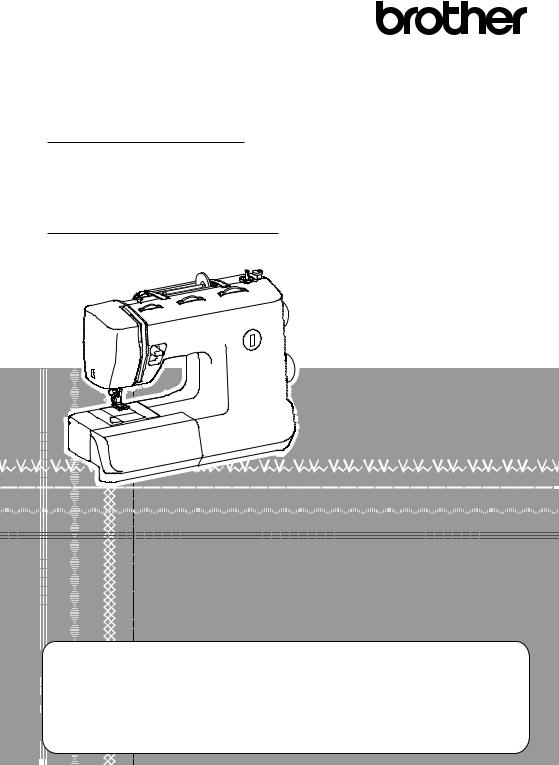
Operation Manual
Sewing Machine
Product Code: 888-X39
Manual de instrucciones
Máquina de coser
Código de producto: 888-X39
ENGLISH 
ESPAÑOL 


 Be sure to read this document before using the machine.
Be sure to read this document before using the machine.


 We recommend that you keep this document nearby for future reference.
We recommend that you keep this document nearby for future reference.


 Lea
Lea este documento antes de utilizar la máquina.
este documento antes de utilizar la máquina.


 Recomendamos que tenga este documento a mano por si necesita consultarlo
Recomendamos que tenga este documento a mano por si necesita consultarlo 

 más adelante.
más adelante.
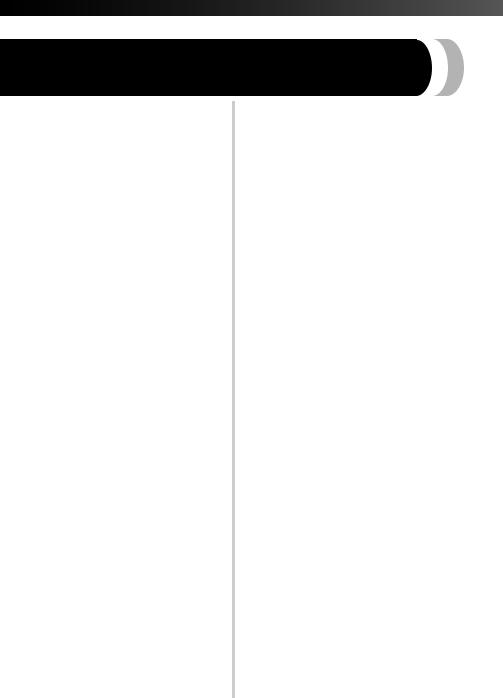
—
IMPORTANT SAFETY
INSTRUCTIONS
Please read these safety instructions
before attempting to use the machine.
 DANGER - To
DANGER - To
reduce the risk of electric shock:
1 Always unplug the machine from the electrical outlet immediately after using, when cleaning, when making any user servicing adjustments mentioned in this manual, or if you are leaving the machine unattended.
 WARNING - To
WARNING - To
reduce the risk of burns, fire, electric shock, or injury to persons.
2 Always unplug the machine from the electrical outlet when making any adjustments mentioned in the instruction manual:
•To unplug the machine, switch the machine to the symbol “O” position to turn it off, then grasp the plug and pull it out of the electrical outlet. Do not pull on the cord.
•Plug the machine directly into the electrical outlet. Do not use an extension cord.
•Always unplug your machine if the power is cut.
3 Never operate this machine if it has a damaged cord or plug, if it is not working properly, if it has been dropped or damaged, or water is spilled on the unit. Return the machine to the nearest authorized dealer or service center for examination, repair, electrical or mechanical adjustment.
•While the machine is stored or in use if you notice anything unusual, such as an odor, heat, discoloration or deformation, stop using the machine
and immediately unplug the power cord.
•When transporting the machine, be sure to carry it by its handle. Lifting the machine by any other part may damage the machine or result in the machine falling, which could cause injuries.
•When lifting the machine, be careful not to make any sudden or careless movements, otherwise you may injure your back or knees.
4 Always keep your work area clear:
•Never operate the machine with any air openings blocked. Keep ventilation openings of the machine and foot control free from the build up of lint, dust, and loose cloth.
•Do not store objects on the foot controller.
•Do not use extension cords. Plug the machine directly into the electrical outlet.
•Never drop or insert any object into any opening.
•Do not operate where aerosol (spray) products are being used or where oxygen is being administered.
•Do not use the machine near a heat source, such as a stove or iron; otherwise, the machine, power cord or garment being sewn may ignite, resulting in fire or an electric shock.
•Do not place this machine on an unstable surface, such as an unsteady or slanted table, otherwise the machine may fall, resulting in injuries.
5 Special care is required when sewing:
•Always pay close attention to the needle. Do not use bent or damaged needles.
1
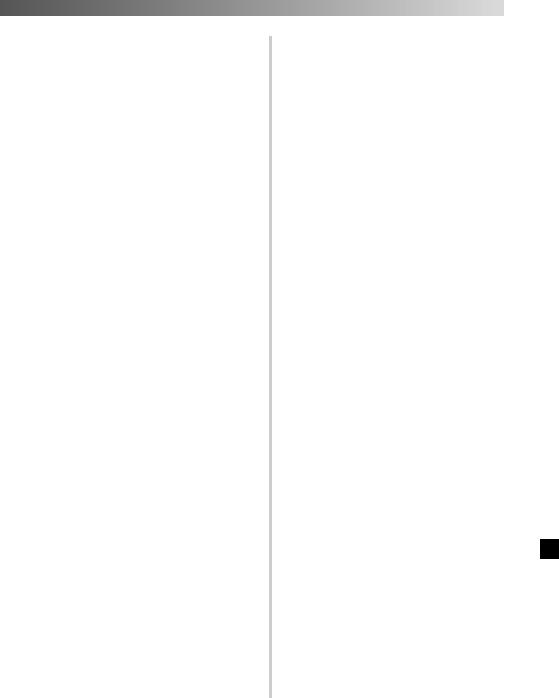
———————
•Keep fingers away from all moving parts. Special care is required around the machine needle.
•Do not turn on the machine while pressing down the foot controller. The machine may start unexpectedly and cause personal injury or damage to the machine.
•Switch the machine to the symbol “O” position to turn it off when making any adjustments in the needle area.
•Do not use a damaged or incorrect needle plate, as it could cause the needle to break.
•Do not push or pull the fabric when sewing, and follow careful instruction when freehand stitching so that you do not deflect the needle and cause it to break.
6 This machine is not a toy:
•Your close attention is necessary when the machine is used by or near children.
•The plastic bag that this machine was supplied in should be kept out of the reach of children or disposed of.
Never allow children to play with the bag due to the danger of suffocation.
•Do not use outdoors.
7 For a longer service life:
•When storing this machine, avoid direct sunlight and high humidity locations. Do not use or store the machine near a space heater, iron, halogen lamp, or other hot objects.
•Use only neutral soaps or detergents to clean the plastic parts. Benzene, thinner, and scouring powders can damage the machine, and should never be used.
•Always consult the operation manual when replacing or installing any assemblies, the presser feet, needle, or other parts to assure correct installation.
8 For repair or adjustment:
•If the Light unit (light-emitting diode) is damaged, it must be replaced by authorized dealer.
•In the event a malfunction occurs or adjustment is required, first follow the troubleshooting table in the back of
the operation manual to inspect and adjust the machine yourself. If the problem persists, please consult your local authorized Brother dealer.
Use this machine only for its intended use as described in this manual.
Use accessories recommended by the manufacturer as contained in this manual.
The contents of this manual and specifications of this product are subject to change without notice.
For additional product information, visit our web site at www.brother.com
SAVE THESE
INSTRUCTIONS
This machine is intended for household use.
FOR USERS IN COUNTRIES EXCEPT EUROPEAN COUNTRIES
This appliance is not intended for use by persons (including children) with reduced physical, sensory or mental capabilities, or lack of experience and knowledge, unless they have been given supervision or instruction concerning use of the appliance by a person responsible for their safety. Children should be supervised to ensure that they do not play with the appliance.
FOR USERS IN EUROPEAN COUNTRIES
This appliance can be used by children aged from 8 years and above and persons with reduced physical, sensory or mental capabilities or lack of experience and knowledge if they have been given supervision or instruction concerning use of the appliance in a safe way and understand the hazards involved. Children shall not play with the appliance. Cleaning and user maintenance shall not be made by children without supervision.
2
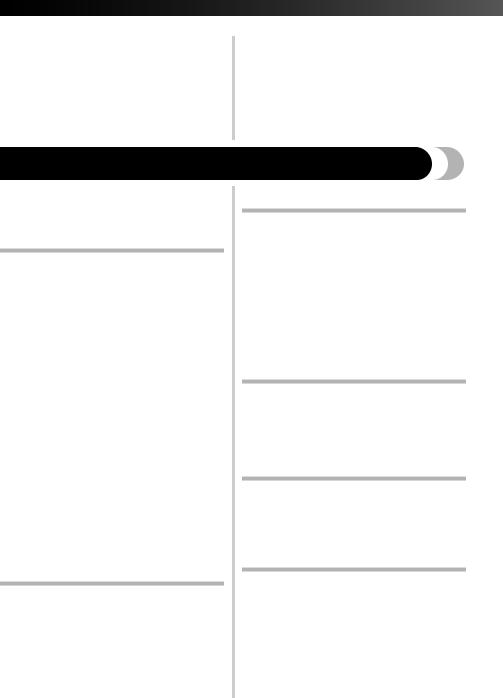
FOR USERS IN THE UK, EIRE, MALTA AND CYPRUS ONLY
IMPORTANT
•In the event of replacing the plug fuse, use a fuse
approved by ASTA to BS 1362, i.e. carrying the  mark, rating as marked on plug.
mark, rating as marked on plug.
CONTENTS |
|
IMPORTANT SAFETY INSTRUCTIONS ........... |
1 |
1. KNOWING YOUR SEWING |
|
MACHINE .................................. |
4 |
ACCESSORIES ................................................. |
4 |
Optional accessories .......................................... |
4 |
THE MAIN PARTS ........................................... |
5 |
Flat bed attachment ............................................ |
5 |
USING YOUR SEWING MACHINE ................ |
6 |
Connecting plugs ............................................... |
6 |
Main power and sewing light switch .................. |
7 |
Foot controller .................................................... |
7 |
Checking the needle ........................................... |
7 |
Replacing the needle .......................................... |
7 |
Changing the presser foot ................................... |
8 |
THE CONTROLS ............................................. |
9 |
Pattern selection dial .......................................... |
9 |
Stretch stitching .................................................. |
9 |
Patterns and stitch names ................................. |
10 |
Stitch length dial .............................................. |
13 |
Stitch width dial ............................................... |
13 |
Reverse sewing lever ........................................ |
13 |
Feed dog position switch .................................. |
14 |
THREADING THE MACHINE ....................... |
14 |
Winding the bobbin ......................................... |
14 |
Lower threading ............................................... |
17 |
Upper threading ............................................... |
19 |
Drawing up the lower thread ............................ |
23 |
FABRIC, THREAD, AND NEEDLE |
|
COMBINATIONS ......................................... |
24 |
2. SEWING BASICS ...................... |
25 |
Please read before sewing ................................ |
25 |
Starting sewing ................................................. |
25 |
Trial sewing ...................................................... |
26 |
Changing the sewing direction ......................... |
26 |
Sewing thick fabrics ......................................... |
27 |
Sewing thin fabrics ........................................... |
28 |
Sewing stretch fabrics ....................................... |
28 |
Stitching cylindrical pieces ............................... |
28 |
Sewing with a twin needle ............................... |
28 |
Thread tension ................................................. |
30 |
—
•Always replace the fuse cover. Never use plugs with the fuse cover omitted.
•If the available electrical outlet is not suitable for the plug supplied with this equipment, you should contact your authorized Brother dealer to obtain the correct lead.
3. BUILT-IN STITCHES ................. |
32 |
Straight stitching ............................................... |
32 |
Zigzag stitching ................................................. |
32 |
Blind hem stitching ........................................... |
32 |
Shell tuck stitching ............................................ |
34 |
Elastic stitching ................................................. |
34 |
Double action stitching ..................................... |
35 |
Fagoting ............................................................ |
35 |
Overedge stitching ............................................ |
36 |
Feather stitching ................................................ |
36 |
Triple zigzag stretch stitching ............................ |
37 |
Decorative stitching .......................................... |
37 |
4. SEWING BUTTONHOLES AND |
|
BUTTONS ............................... |
38 |
Making a buttonhole (1-step automatic |
|
buttonhole) ....................................................... |
38 |
Adjusting buttonholes ....................................... |
40 |
Sewing buttons ................................................. |
41 |
5. USING ATTACHMENTS AND |
|
APPLICATIONS ....................... |
42 |
Zipper insertion ................................................ |
42 |
Gathering .......................................................... |
43 |
Darning ............................................................ |
43 |
Appliqués ......................................................... |
43 |
Using the blind stitch foot ................................. |
44 |
6. APPENDIX ................................ |
45 |
MAINTENANCE ........................................... |
45 |
Restrictions on oiling ........................................ |
45 |
Precautions on storing the machine .................. |
45 |
Cleaning ........................................................... |
45 |
TROUBLESHOOTING .................................. |
47 |
INDEX .......................................................... |
50 |
3

———————
1 KNOWING YOUR SEWING MACHINE
1
ACCESSORIES
We have designed these accessories to help you easily perform most sewing tasks.
1. |
2. |
3. |
4. |
5. |
6. |
7. |
8. |
9. |
10. |
11. |
12. |
13. |
14. |
15. |
16. |
17 |
No. |
Part Name |
Part Code |
|
1 |
Zigzag foot “J” |
XZ5136-001 |
|
(on machine) |
|||
|
|
||
2 |
Buttonhole foot “A” |
XD1792-031 |
|
3 |
Zipper foot “I” |
XE9369-001 |
|
4 |
Button sewing foot “M” |
XE2137-001 |
|
5 |
Blind stitch foot |
XF1639-001 |
|
6 |
Non stick foot |
SA114 |
|
7 |
Extra spool pin |
XE2241-001 |
|
8 |
Spool cap “A” |
130012-024 |
|
9 |
Spool cap “B” |
130013-124 |
|
10 |
Bobbin |
SA156 |
|
(One is on machine) |
|||
|
|
No. |
Part Name |
Part Code |
|
11 |
Twin needle |
X57521-021 |
|
(2.0/75 needle) |
|||
|
|
||
12 |
Needle set |
3-piece set: XE5328-001 |
|
(90/14 needle) |
2-piece set: XE7064-001 |
||
|
|||
13 |
Finger Guard |
XG3437-001 |
|
14 |
Disc-shaped |
XC1074-051 |
|
screwdriver |
|||
|
|
||
15 |
Screwdriver |
XF3557-001 |
|
16 |
Foot controller |
See page 5 |
|
17 |
Soft cover |
X53984-027 |
Optional accessories
The following are available as optional accessories to be purchased separately.
1. |
2. |
3. |
4. |
5. |
No. |
Part Name |
Part Code |
|
|
1 |
Walking foot |
SA140 |
|
|
2 |
Quilting foot |
SA129 |
|
|
3 |
1/4-inch quilting foot |
SA125 |
|
|
4 |
Narrow hemmer foot |
SA126 |
|
|
5 |
Quilting guide |
SA132 |
|
|
4
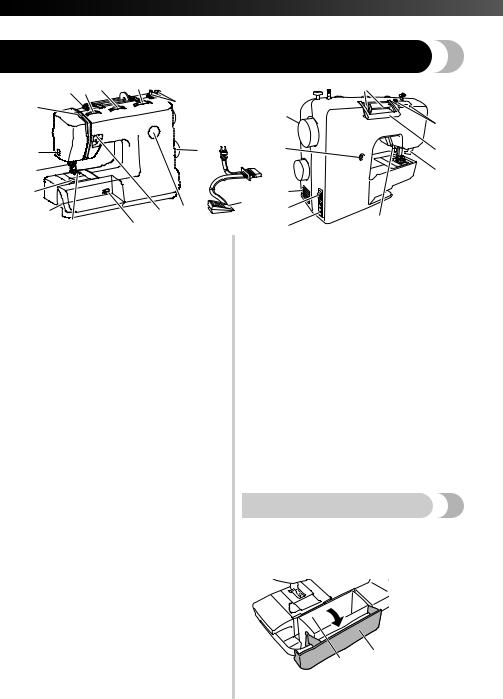
KNOWING YOUR SEWING MACHINE —
THE MAIN PARTS
5 43 |
2 |
|
O |
|
|
|
|||
6 |
1 |
|
|
|
|
F |
|
||
|
|
|
||
|
|
|
N |
|
7 |
E |
G |
M |
|
8 |
|
|
L |
|
9 |
P |
H |
|
|
0 |
I |
|
||
C D |
|
K |
||
A |
B |
J |
||
|
1Bobbin winder (Page 14)
This winds the thread onto the bobbin for use as the lower thread.
2Stitch length dial (Page 13)
Rotate the dial to control the stitch length.
3Stitch width dial (Page 13)
Rotate the dial to control the stitch width.
4Upper tension-control dial (Page 30)
This controls the tension of the upper thread.
5Bobbin-winding thread guide and pre-tension disc (Page 14, 19)
6 Thread take-up lever (Page 21)
7Thread cutter (Page 26)
Pass the threads through the thread cutter to cut them.
8 Needle threader (Page 22)
9 Quick-set bobbin (Page 17, 23)
0 Flat bed attachment with accessory compartment (Page 5) A Presser foot (Page 8)
B Feed dog position switch (Page 14)
CReverse sewing lever (Page 13)
Push this lever to stitch in the reverse direction.
DPattern indication window (Page 9)
Shows the stitch number to be performed.
EPattern selection dial (Page 9)
Rotate the dial in either direction to choose the stitch you want.
FHandwheel
Used to manually raise and lower the needle.
G Buttonhole fine-adjustment screw (Page 40)
HAir vent
Do not cover the air vent while the machine is being used.
IMain power and sewing light switch (Page 7)
You can turn the main power and sewing light switch on and off.
JFoot controller jack / socket (Page 6)
Plug in the foot controller plug and connect the machine to the power supply.
KPresser foot lever (Page 19)
Used to raise and lower the presser foot.
LButtonhole lever (1-Step automatic buttonhole) (Page 38)
Lower the buttonhole lever when sewing buttonholes.
MHandle
Carry the sewing machine by its handle when transporting the machine.
NThread guide (Page 16, 20)
This is used when winding the thread onto the bobbin and then threading the machine.
OSpool pin and spool cap (Page 15, 20)
This holds the spool of thread.
PFoot controller (Page 7)
You can use this to control the sewing speed, and to
start and stop sewing. Foot Controller:
Model KD-1902 for 110-120V area
KD-1902 for 110-127V area (Brazil only) Model KD-2902 for 220-240V area
The foot controller part code differs depending on the country or region. Contact your dealer or the nearest authorized service center.
Flat bed attachment
The accessories are stored in the storage space in the flat bed attachment.
1Swing the lid of the flat bed attachment toward you to open the storage space.
|
1 |
Flat bed |
a |
|
attachment |
2 |
Accessory |
|
b |
|
compartment |
|
|
XThe bag of accessories is in the storage space.
5
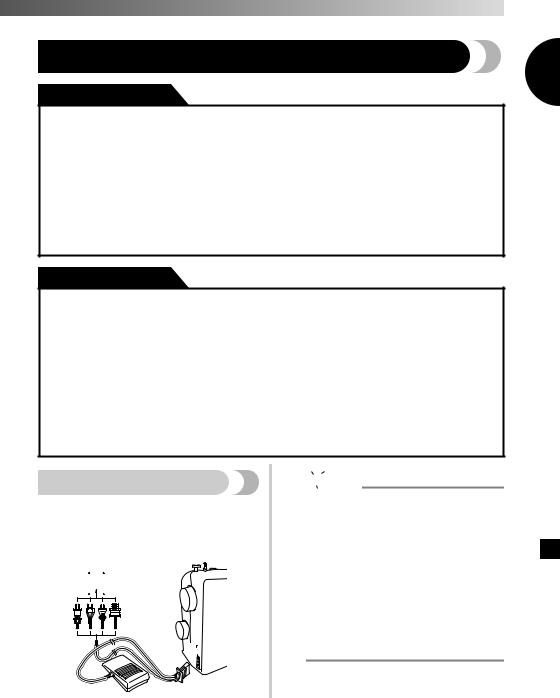
USING YOUR SEWING MACHINE
1
 WARNING
WARNING
●Use only regular household electricity for the power source. Using other power sources may result in fire, electric shock, or damage to the machine.
●Make sure that the plugs on the power cord are firmly inserted into the electrical outlet and the power supply jack on the machine.
●Do not insert the plug on the power cord into an electrical outlet that is in poor condition.
●Turn off the main power and remove the plug in the following circumstances:
•When you are away from the machine
•After using the machine
•When the power fails during use
•When the machine does not operate correctly due to a bad connection or a disconnection
•During electrical storms
 CAUTION
CAUTION
●Use only the power cord included with this machine.
●Do not use extension cords or multi-plug adapters with many other appliances plugged in to them. Fire or electric shock may result.
●Do not touch the plug with wet hands. Electric shock may result.
●When unplugging the machine, always turn off the main power first. Always grasp the plug to remove it from the outlet. Pulling on the cord may damage the cord, or lead to fire or electric shock.
●Do not allow the power cord to be cut, damaged, modified, forcefully bent, pulled, twisted, or bundled. Do not place heavy objects on the cord. Do not subject the cord to heat. These things may damage the cord and cause fire or electric shock. If the cord or plug is damaged, take the machine to your authorized dealer for repairs before continuing use.
●Unplug the power cord if the machine is not to be used for a long period of time. Otherwise a fire may result.
Connecting plugs
1Connect the foot controller plug to the machine.
2Connectoutlet. the power supply plug to a wall
 b
b
a 



 Note
Note
●If a power outage occurs while the sewing machine is being operated, turn off the main power and unplug the power supply cord. When restarting the sewing machine, follow the necessary procedure to correctly operate the machine.
●This appliance has a polarized plug (one blade wider than the other). To reduce the risk of electric shock, this plug is intended to fit in a polarized outlet only one way. If the plug does not fit fully in the outlet, reverse the plug.
If it still does not fit, contact a qualified electrician to install the proper outlet. Do not modify the plug in any way.
6
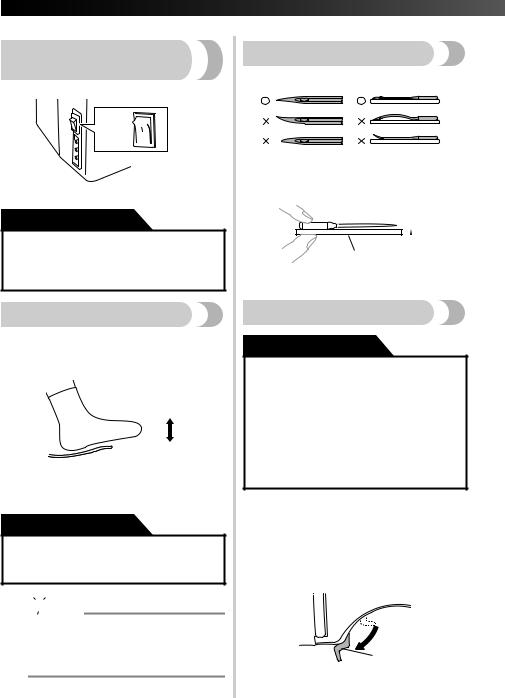
KNOWING YOUR SEWING MACHINE |
— |
Main power and sewing light switch
This switch turns the main power and sewing light on or off.
1


2

1 Turn on (toward the ‘I’ mark)
2 Turn off (toward the ‘O’ mark)
 CAUTION
CAUTION
●Do not turn on the machine while pressing down the foot controller. The machine may start unexpectedly and cause personal injury or damage to the machine.
Foot controller
When you press the foot controller down lightly, the machine will run at a low speed. When you press harder, the machine’s speed will increase. When you take your foot off the foot controller, the machine will stop.
1
 2
2
1 Slower
2 Faster
You should make sure that nothing is placed on the foot controller when the machine is not in use.
 CAUTION
CAUTION
●Do not allow pieces of cloth and dust to build up on the foot controller. Doing so could cause a fire or an electric shock.


 Note
Note
●Foot Controller: Model KD-1902
This foot controller can be used on the machine with product code 888-X39.
The product code is mentioned on the machine rating plate.
Checking the needle
The sewing needle must always be straight and sharp for smooth sewing.
■Checking the needle correctly
Put the flat side of the needle on a flat surface. Check the needle from the top and the sides. Dispose of any bent needles safely.
 1
1
2
1 Parallel space
2 Level surface (bobbin cover, glass, etc.)
Replacing the needle
 CAUTION
CAUTION
●Always turn off the machine before you change the needle. Otherwise, injuries may occur if the foot controller is accidentally pressed and the machine starts sewing.
●Only use sewing machine needles for home use. Other needles may bend or break and cause injury.
●Never sew with a bent needle. A bent needle will easily break and cause injury.
1Turn off the machine.
2Raise the needle by turning the handwheel toward you (counterclockwise) so that the mark on the wheel points up.
3Lower the presser foot lever.
1
1 Presser foot lever
7
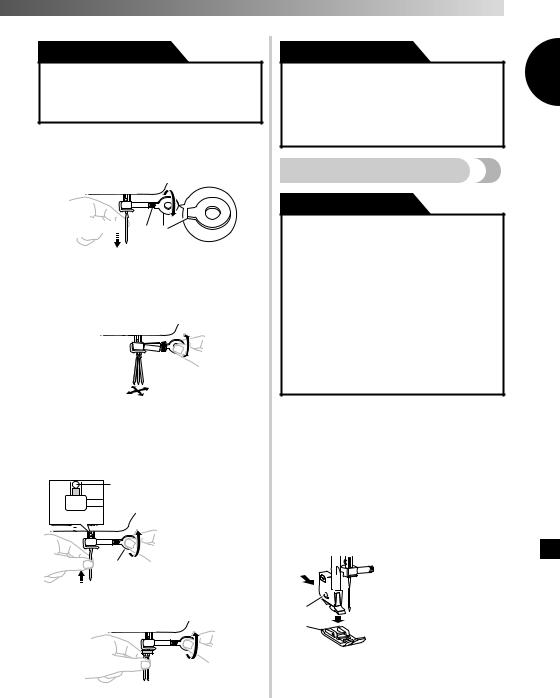
 CAUTION
CAUTION
●Before replacing the needle, place fabric or paper under the presser foot to prevent the needle from falling into the hole in the needle plate.
4Hold the needle with your left hand, and then use a disc-shaped screwdriver to turn the needle clamp screw counterclockwise to remove the needle.
 2 1
2 1
1 Use a disc-shaped screwdriver
2 Needle clamp screw
•Do not use excessive force when loosening or tightening the needle clamp screw, otherwise certain parts of the sewing machine may be damaged.
5With the flat side of the needle toward the back of the machine, insert the needle until it touches the needle stopper. Next, tighten the needle clamp using a discshaped screwdriver.
2
 3
3
1 |
1 |
Use a disc-shaped |
|
screwdriver |
|
|
|
|
|
2 |
Needle stopper |
|
3 |
Needle |
Install the twin needle in the same way.
 CAUTION
CAUTION
● Make sure you insert the needle until it |
1 |
touches the stopper, and securely tighten |
|
the needle clamp screw with a disc- |
|
shaped screwdriver, otherwise the |
|
needle may break or the machine may be |
|
damaged. |
|
Changing the presser foot
 CAUTION
CAUTION
●Always turn off the machine before you change the presser foot. If you leave the power on and step on the controller, the machine will start and you may be injured.
●Always use the correct presser foot for the stitch pattern you have chosen. If you use the wrong presser foot, the needle may strike the presser foot and bend or break, and may cause injury.
●Only use presser feet that have been designed to be used with this machine. Using any other presser foot may cause accident or injury.
You will have to change the presser foot depending on what you want to sew and how.
1Turn off the machine. Raise the presser foot lever.
2Raise the needle by turning the handwheel toward you (counterclockwise) so that the mark on the wheel points up.
3Press the black button at the back of the presser foot holder to release the presser foot.
1


2
3 |
1 |
Black button |
|
2 |
Presser foot holder |
|
3 |
Presser foot |
4Put a different presser foot on the needle plate so that the bar on the presser foot is in line with the slot on the shank.
8

KNOWING YOUR SEWING MACHINE
5Lower the presser foot lever and fix the presser foot onto the shank. If the presser foot is in the correct place, the bar should snap in.
1

 2
2
1 Shank
2 Bar
—
■ Presser foot installation orientation
 CAUTION
CAUTION
●If the presser foot is not installed with the correct orientation, the needle may strike the presser foot, which may bend or break the needle and cause injury.
THE CONTROLS
Pattern selection dial
 CAUTION
CAUTION
●When you use the pattern selection dial to choose a pattern, raise the needle by turning the handwheel toward you (counterclockwise) so that the mark on the wheel points up. If the needle is in the down position when you turn the pattern selection dial, the needle, presser foot or fabric may be damaged.
To select a stitch, simply turn the pattern selection dial, located on the right side of the machine. The pattern selection dial may be turned in either direction. The next section shows recommended stitch lengths and widths.
|
• |
The pattern number |
|
|
display does not rotate |
|
|
endlessly. If you set |
|
|
the pattern selection |
|
|
dial to the highest or |
|
|
lowest pattern and |
|
|
continue to turn it in |
|
1 |
the same direction, the |
2 |
dial will spin freely but |
the pattern will not change.
1 Pattern selection dial
2 Chosen pattern number
Stretch stitching
Raise the needle by turning the handwheel toward you (counterclockwise) so that the mark on the wheel points up.
Setting the stitch length dial to “  1 ” changes the selected pattern to a stretch stitch.
1 ” changes the selected pattern to a stretch stitch.
*To set the dial to “SS2”, set it to “SS1”, and then turn the dial further to the left (direction of the arrow).
9
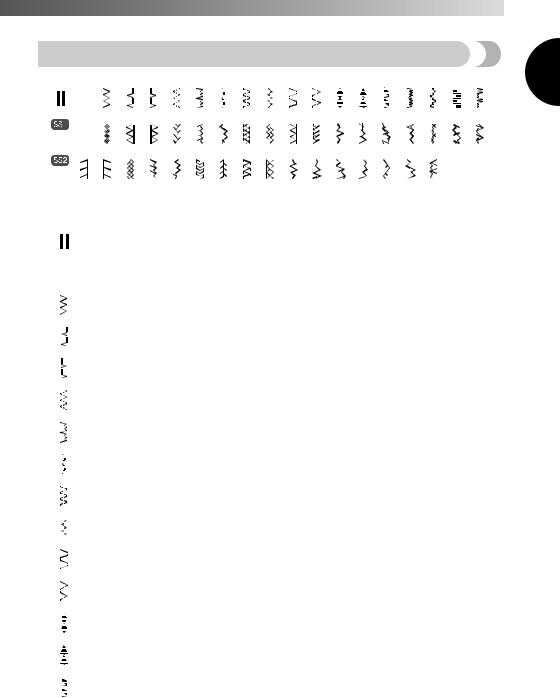
Patterns and stitch names
|
|
|
|
|
|
|
|
|
|
|
|
|
|
|
|
|
|
|
|
|
|
|
|
|
1 |
||
|
1 |
|
|
2 |
3 |
4 |
5 |
6 |
7 |
8 |
9 |
10 |
11 |
12 |
13 |
14 |
15 |
16 |
17 |
18 |
19 |
||||||
|
|
|
|
|
|
|
|
|
|
|
|
|
|
|
|
|
|
|
|
|
|
|
|
|
|
|
|
|
|
|
|
|
|
|
|
|
|
|
|
|
|
|
|
|
|
|
|
|
|
|
|
|
|
|
|
|
|
|
|
|
|
|
|
|
|
|
|
|
|
|
|
|
|
|
|
|
|
|
|
|
|
|
|
|
|
|
|
|
|
|
|
|
|
|
|
|
|
|
|
|
|
|
|
|
|
|
|
|
|
|
|
|
|
|
|
|
|
|
|
|
|
|
|
|
|
|
|
|
|
|
|
|
|
|
|
|
|
|
|
|
1 |
|
20 |
21 |
22 |
23 |
24 |
25 |
26 |
27 |
28 |
29 |
30 |
31 |
32 |
33 |
34 |
35 |
36 |
37 |
|
|
|
||||
|
|
|
|
|
|
|
|
|
|
|
|
|
|
|
|
|
|
|
|
|
|
|
|
||||
|
|
|
|
|
|
|
|
|
|
|
|
|
|
|
|
|
|
|
|
|
|
|
|
|
|
|
|
|
|
|
|
|
|
|
|
|
|
|
|
|
|
|
|
|
|
|
|
|
|
|
|
|
|
|
|
|
|
|
|
|
|
|
|
|
|
|
|
|
|
|
|
|
|
|
|
|
|
|
|
|
|
|
|
|
|
|
|
|
|
|
|
|
|
|
|
|
|
|
|
|
|
|
|
|
|
|
|
|
|
|
|
|
|
|
|
|
|
38 |
39 |
40 |
41 |
42 |
43 |
44 |
45 |
46 |
47 |
48 |
49 |
50 |
51 |
52 |
53 |
|
|
|
|
|
|
|
|
|
|
|
|
|
|
|
|
|
|
|
|
|
|
|
|
|
|
|
|
|
|
||||
|
|
|
|
|
|
|
|
|
|
|
|
|
|
|
|
|
|
|
|
|
|
|
|
|
|
|
|
|
Pattern |
|
|
|
|
Stitch Name |
|
|
|
Recommended |
|
Recommended |
|
Reference |
|
|
|||||||||||
|
|
|
|
|
|
|
|
|
Width |
|
|
|
Length |
|
|
||||||||||||
|
|
|
|
|
|
|
|
|
|
|
|
|
Page |
|
|
||||||||||||
|
|
|
|
|
|
|
|
|
|
|
|
|
|
|
(mm (inch)) |
|
|
(mm (inch)) |
|
|
|||||||
|
|
|
|
|
|
|
|
|
|
|
|
|
|
|
|
|
|
|
|
|
|
|
|||||
1 |
|
|
|
|
1-STEP AUTOMATIC |
|
|
|
3-5 |
|
|
|
F-1.5 |
|
|
|
|
|
|
|
|||||||
|
|
|
|
|
|
|
|
|
|
|
(1/8-3/16) |
|
|
|
|
|
|
38 |
|
|
|
||||||
|
|
|
|
|
|
|
|
|
BUTTONHOLE |
|
|
|
|
|
(1/64-1/16) |
|
|
|
|
|
|||||||
|
|
|
|
|
|
|
|
|
|
|
(Dial 4-7) |
|
|
|
|
|
|
|
|
|
|||||||
|
|
|
|
|
|
|
|
|
|
|
|
|
|
|
|
|
|
|
|
|
|
|
|
|
|
||
2 |
|
|
|
|
STRAIGHT STITCH |
|
|
|
6.5 |
|
|
|
1-4 |
|
|
32, 42, 43, 44 |
|
|
|||||||||
|
|
|
|
|
|
|
|
|
|
|
|
|
|
|
|
|
|
|
|||||||||
|
|
|
|
|
|
|
|
|
|
|
|
(1/4) |
|
|
|
(1/16-3/16) |
|
|
|
||||||||
|
|
|
|
|
|
|
|
|
|
|
|
|
|
|
|
|
|
|
|
|
|
|
|
|
|||
|
|
|
|
|
|
|
|
|
|
|
|
|
|
|
|
|
|
|
|
|
|
|
|
|
|
|
|
3 |
|
|
|
|
ZIGZAG STITCH |
|
|
|
0-6.5 |
|
|
|
F-4 |
|
|
32, 41, 43, 44 |
|
|
|||||||||
|
|
|
|
|
|
|
|
|
|
|
|
|
|
|
|
|
|
|
|||||||||
|
|
|
|
|
|
|
|
|
|
|
|
(0-1/4) |
|
|
|
(1/64-3/16) |
|
|
|
||||||||
|
|
|
|
|
|
|
|
|
|
|
|
|
|
|
|
|
|
|
|
|
|
|
|
|
|||
|
|
|
|
|
|
|
|
|
|
|
|
|
|
|
|
|
|
|
|
|
|
|
|
|
|
|
|
4 |
|
|
|
|
BLIND HEM STITCH |
|
|
|
3-6.5 |
|
|
|
F-2 |
|
|
32, 44 |
|
|
|
||||||||
|
|
|
|
|
|
|
|
|
|
|
|
|
|
|
|
|
|
|
|
||||||||
|
|
|
|
|
|
|
|
|
|
|
|
(1/8-1/4) |
|
|
|
(1/64-1/16) |
|
|
|
|
|||||||
|
|
|
|
|
|
|
|
|
|
|
|
|
|
|
|
|
|
|
|
|
|
|
|
|
|||
|
|
|
|
|
|
|
|
|
|
|
|
|
|
|
|
|
|
|
|
|
|
|
|
|
|
|
|
5 |
|
|
|
|
SHELL TUCK STITCH |
|
|
|
3-6.5 |
|
|
|
F-3 |
|
|
|
34 |
|
|
|
|||||||
|
|
|
|
|
|
|
|
|
|
|
|
|
|
|
|
|
|
|
|
|
|||||||
|
|
|
|
|
|
|
|
|
|
|
|
(1/8-1/4) |
|
|
|
(1/64-1/8) |
|
|
|
|
|
||||||
|
|
|
|
|
|
|
|
|
|
|
|
|
|
|
|
|
|
|
|
|
|
|
|
|
|||
|
|
|
|
|
|
|
|
|
|
|
|
|
|
|
|
|
|
|
|
|
|
|
|
|
|
|
|
6 |
|
|
|
|
ELASTIC STITCH |
|
|
|
3-6.5 |
|
|
|
F-2.5 |
|
|
|
34 |
|
|
|
|||||||
|
|
|
|
|
|
|
|
|
|
|
|
|
|
|
|
|
|
|
|
|
|||||||
|
|
|
|
|
|
|
|
|
|
|
|
(1/8-1/4) |
|
|
|
(1/64-3/32) |
|
|
|
|
|
||||||
|
|
|
|
|
|
|
|
|
|
|
|
|
|
|
|
|
|
|
|
|
|
|
|
|
|||
|
|
|
|
|
|
|
|
|
|
|
|
|
|
|
|
|
|
|
|
|
|
|
|
|
|
|
|
7 |
|
|
|
STRETCH BLIND HEM STITCH |
|
|
3-6.5 |
|
|
|
F-1.5 |
|
|
32, 44 |
|
|
|
||||||||||
|
|
|
|
|
|
|
|
|
|
|
|
|
|
|
|
|
|
||||||||||
|
|
|
|
|
|
|
|
|
|
(1/8-1/4) |
|
|
|
(1/64-1/16) |
|
|
|
|
|||||||||
|
|
|
|
|
|
|
|
|
|
|
|
|
|
|
|
|
|
|
|
|
|
|
|
|
|||
|
|
|
|
|
|
|
|
|
|
|
|
|
|
|
|
|
|
|
|
|
|
|
|
|
|
|
|
8 |
|
|
|
|
SCALLOP STITCH |
|
|
|
3-6.5 |
|
|
|
F-1.5 |
|
|
|
37 |
|
|
|
|||||||
|
|
|
|
|
|
|
|
|
|
|
|
|
|
|
|
|
|
|
|
|
|||||||
|
|
|
|
|
|
|
|
|
|
|
|
(1/8-1/4) |
|
|
|
(1/64-1/16) |
|
|
|
|
|
||||||
|
|
|
|
|
|
|
|
|
|
|
|
|
|
|
|
|
|
|
|
|
|
|
|
|
|||
|
|
|
|
|
|
|
|
|
|
|
|
|
|
|
|
|
|
|
|
|
|
|
|
|
|
|
|
9 |
|
|
|
DOUBLE ACTION STITCH |
|
|
|
3-6.5 |
|
|
|
F-3 |
|
|
|
35 |
|
|
|
||||||||
|
|
|
|
|
|
|
|
|
|
|
|
|
|
|
|
|
|
|
|
||||||||
|
|
|
|
|
|
|
|
|
|
|
(1/8-1/4) |
|
|
|
(1/64-1/8) |
|
|
|
|
|
|||||||
|
|
|
|
|
|
|
|
|
|
|
|
|
|
|
|
|
|
|
|
|
|
|
|
|
|||
|
|
|
|
|
|
|
|
|
|
|
|
|
|
|
|
|
|
|
|
|
|
|
|
|
|
|
|
10 |
|
|
|
BRIDGING STITCH |
|
|
|
3-6.5 |
|
|
|
F-3 |
|
|
|
35 |
|
|
|
||||||||
|
|
|
|
|
|
|
|
|
|
|
|
|
|
|
|
|
|
|
|
|
|||||||
|
|
|
|
|
|
|
|
|
|
|
|
(1/8-1/4) |
|
|
|
(1/64-1/8) |
|
|
|
|
|
||||||
|
|
|
|
|
|
|
|
|
|
|
|
|
|
|
|
|
|
|
|
|
|
|
|
|
|||
|
|
|
|
|
|
|
|
|
|
|
|
|
|
|
|
|
|
|
|
|
|
|
|
|
|
|
|
11 |
|
|
|
RAMPART STITCH |
|
|
|
3-6.5 |
|
|
|
F-3 |
|
|
|
35 |
|
|
|
||||||||
|
|
|
|
|
|
|
|
|
|
|
|
|
|
|
|
|
|
|
|
|
|||||||
|
|
|
|
|
|
|
|
|
|
|
|
(1/8-1/4) |
|
|
|
(1/64-1/8) |
|
|
|
|
|
||||||
|
|
|
|
|
|
|
|
|
|
|
|
|
|
|
|
|
|
|
|
|
|
|
|
|
|||
|
|
|
|
|
|
|
|
|
|
|
|
|
|
|
|
|
|
|
|
|
|
|
|
|
|
|
|
12 |
|
|
ELASTIC SHELL TUCK STITCH |
|
|
3-6.5 |
|
|
|
F-3 |
|
|
|
36 |
|
|
|
||||||||||
|
|
|
|
|
|
|
|
|
|
|
|
|
|
|
|
|
|
|
|||||||||
|
|
|
|
|
|
|
|
|
|
(1/8-1/4) |
|
|
|
(1/64-1/8) |
|
|
|
|
|
||||||||
|
|
|
|
|
|
|
|
|
|
|
|
|
|
|
|
|
|
|
|
|
|
|
|
|
|||
|
|
|
|
|
|
|
|
|
|
|
|
|
|
|
|
|
|
|
|
|
|
|
|
|
|
|
|
13 |
|
|
|
|
BEAD STITCH |
|
|
|
|
3-6.5 |
|
|
|
F-1.5 |
|
|
|
37 |
|
|
|
||||||
|
|
|
|
|
|
|
|
|
|
|
|
|
|
|
|
|
|
|
|
|
|
|
|||||
|
|
|
|
|
|
|
|
|
|
|
|
|
|
(1/8-1/4) |
|
|
|
(1/64-1/16) |
|
|
|
|
|
||||
|
|
|
|
|
|
|
|
|
|
|
|
|
|
|
|
|
|
|
|
|
|
|
|
|
|||
|
|
|
|
|
|
|
|
|
|
|
|
|
|
|
|
|
|
|
|
|
|
|
|
|
|
|
|
14 |
|
|
|
ARROWHEAD STITCH |
|
|
|
3-6.5 |
|
|
|
F-1.5 |
|
|
|
37 |
|
|
|
||||||||
|
|
|
|
|
|
|
|
|
|
|
|
|
|
|
|
|
|
|
|
|
|||||||
|
|
|
|
|
|
|
|
|
|
|
|
(1/8-1/4) |
|
|
|
(1/64-1/16) |
|
|
|
|
|
||||||
|
|
|
|
|
|
|
|
|
|
|
|
|
|
|
|
|
|
|
|
|
|
|
|
|
|||
|
|
|
|
|
|
|
|
|
|
|
|
|
|
|
|
|
|
|
|
|
|
|
|
|
|
|
|
15 |
|
|
PARALLELOGRAM STITCH |
|
|
3-6.5 |
|
|
|
F-1.5 |
|
|
|
37 |
|
|
|
||||||||||
|
|
|
|
|
|
|
|
|
|
|
|
|
|
|
|
|
|
|
|||||||||
|
|
|
|
|
|
|
|
|
|
(1/8-1/4) |
|
|
|
(1/64-1/16) |
|
|
|
|
|
||||||||
|
|
|
|
|
|
|
|
|
|
|
|
|
|
|
|
|
|
|
|
|
|
|
|
|
|||
|
|
|
|
|
|
|
|
|
|
|
|
|
|
|
|
|
|
|
|
|
|
|
|
|
|
|
|
10
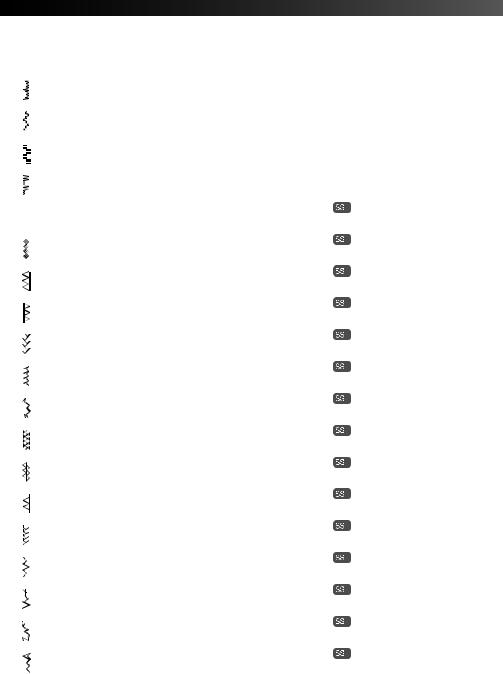
KNOWING YOUR SEWING MACHINE |
|
|
|
— |
||
|
|
|
|
|
|
|
Pattern |
Stitch Name |
Recommended |
Recommended |
Reference |
|
|
Width |
Length |
|
||||
Page |
|
|||||
|
|
|
(mm (inch)) |
(mm (inch)) |
|
|
|
|
|
|
|
||
16 |
SCALLOP STITCH |
3-6.5 |
F-1.5 |
37 |
|
|
|
|
|
||||
|
|
(1/8-1/4) |
(1/64-1/16) |
|
||
|
|
|
|
|
||
|
|
|
|
|
|
|
17 |
LIGHTNING STITCH |
6.5 |
F-1.5 |
37 |
|
|
|
|
|
||||
|
|
(1/4) |
(1/64-1/16) |
|
||
|
|
|
|
|
||
|
|
|
|
|
|
|
18 |
SQUARE STITCH |
6.5 |
F-1.5 |
37 |
|
|
|
|
|
||||
|
|
(1/4) |
(1/64-1/16) |
|
||
|
|
|
|
|
||
|
|
|
|
|
|
|
19 |
DECORATIVE STITCH |
6.5 |
F-1.5 |
37 |
|
|
|
|
|
||||
|
|
(1/4) |
(1/64-1/16) |
|
||
|
|
|
|
|
||
|
|
|
|
|
|
|
20 |
TRIPLE STRETCH STITCH |
6.5 |
1 Fixed |
32 |
|
|
|
|
|
||||
|
|
(1/4) |
2.5 (3/32) |
|
||
|
|
|
|
|
||
|
|
|
|
|
|
|
21 |
TRIPLE ZIGZAG STRETCH STITCH |
3-6.5 |
1 Fixed |
37 |
|
|
|
|
|
||||
|
|
(1/8-1/4) |
2.5 (3/32) |
|
||
|
|
|
|
|
||
|
|
|
|
|
|
|
|
|
|
|
|
|
|
22 |
ELASTIC OVERLOCK STITCH |
3-6.5 |
1 Fixed |
36 |
|
|
|
|
|
||||
|
|
(1/8-1/4) |
2.5 (3/32) |
|
||
|
|
|
|
|
||
|
|
|
|
|
|
|
|
|
|
|
|
|
|
23 |
ELASTIC OVERLOCK STITCH |
3-6.5 |
1 Fixed |
36 |
|
|
|
|
|
||||
|
|
(1/8-1/4) |
2.5 (3/32) |
|
||
|
|
|
|
|
||
|
|
|
|
|
|
|
|
|
|
|
|
|
|
24 |
FEATHER STITCH |
3-6.5 |
1 Fixed |
36 |
|
|
|
|
|
||||
|
|
(1/8-1/4) |
2.5 (3/32) |
|
||
|
|
|
|
|
||
|
|
|
|
|
|
|
|
|
|
|
|
|
|
25 |
COMB STITCH |
3-6.5 |
1 Fixed |
36 |
|
|
|
|
|
||||
|
|
(1/8-1/4) |
2.5 (3/32) |
|
||
|
|
|
|
|
||
|
|
|
|
|
|
|
|
|
|
|
|
|
|
26 |
DECORATIVE STITCH |
6.5 |
1 Fixed |
37 |
|
|
|
|
|
||||
|
|
(1/4) |
2.5 (3/32) |
|
||
|
|
|
|
|
||
|
|
|
|
|
|
|
|
|
|
|
|
|
|
27 |
FAGOTING STITCH |
3-6.5 |
1 Fixed |
35 |
|
|
|
|
|
||||
|
|
(1/8-1/4) |
2.5 (3/32) |
|
||
|
|
|
|
|
||
|
|
|
|
|
|
|
|
|
|
|
|
|
|
28 |
DECORATIVE STITCH |
3-6.5 |
1 Fixed |
35 |
|
|
|
|
|
||||
|
|
(1/8-1/4) |
2.5 (3/32) |
|
||
|
|
|
|
|
||
|
|
|
|
|
|
|
|
|
|
|
|
|
|
29 |
DECORATIVE HEM STITCH |
3-6.5 |
1 Fixed |
35 |
|
|
|
|
|
||||
|
|
(1/8-1/4) |
2.5 (3/32) |
|
||
|
|
|
|
|
||
|
|
|
|
|
|
|
|
|
|
|
|
|
|
30 |
DECORATIVE STITCH |
6.5 |
1 Fixed |
37 |
|
|
|
|
|
||||
|
|
(1/4) |
2.5 (3/32) |
|
||
|
|
|
|
|
||
|
|
|
|
|
|
|
|
|
|
|
|
|
|
31 |
DECORATIVE STITCH |
6.5 |
1 Fixed |
37 |
|
|
|
|
|
||||
|
|
(1/4) |
2.5 (3/32) |
|
||
|
|
|
|
|
||
|
|
|
|
|
|
|
|
|
|
|
|
|
|
32 |
DECORATIVE STITCH |
6.5 |
1 Fixed |
37 |
|
|
|
|
|
||||
|
|
(1/4) |
2.5 (3/32) |
|
||
|
|
|
|
|
||
|
|
|
|
|
|
|
|
|
|
|
|
|
|
33 |
DECORATIVE STITCH |
6.5 |
1 Fixed |
37 |
|
|
|
|
|
||||
|
|
(1/4) |
2.5 (3/32) |
|
||
|
|
|
|
|
||
|
|
|
|
|
|
|
|
|
|
|
|
|
|
34 |
DECORATIVE STITCH |
6.5 |
1 Fixed |
37 |
|
|
|
|
|
||||
|
|
(1/4) |
2.5 (3/32) |
|
||
|
|
|
|
|
||
|
|
|
|
|
|
|
|
|
|
|
|
|
|
11
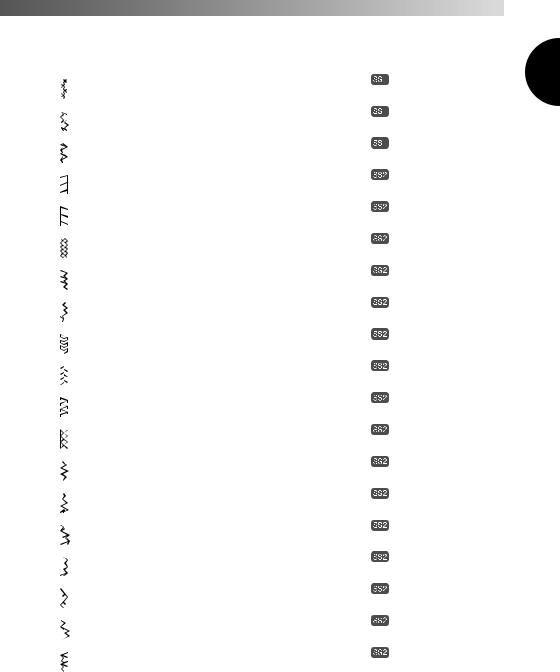
Pattern |
Stitch Name |
Recommended |
Recommended |
Reference |
|
|
|
Width |
Length |
|
|||||
Page |
1 |
||||||
|
|
(mm (inch)) |
(mm (inch)) |
||||
|
|
|
|||||
35 |
LINK STITCH |
3-6.5 |
1 Fixed |
37 |
|||
|
|||||||
|
(1/8-1/4) |
2.5 (3/32) |
|
|
|||
|
|
|
|
|
|||
|
|
|
|
|
|
||
|
|
|
|
|
|
|
|
36 |
DECORATIVE STITCH |
6.5 |
1 Fixed |
37 |
|
|
|
|
(1/4) |
2.5 (3/32) |
|
|
|||
|
|
|
|
|
|||
|
|
|
|
|
|
||
|
|
|
|
|
|
|
|
37 |
DECORATIVE STITCH |
6.5 |
1 Fixed |
37 |
|
|
|
|
|
|
|||||
|
(1/4) |
2.5 (3/32) |
|
|
|||
|
|
|
|
|
|||
|
|
|
|
|
|
||
|
|
|
|
|
|
|
|
38 |
STRETCH OVERLOCK STITCH |
3-6.5 |
Fixed |
37 |
|
|
|
|
|
|
|||||
|
(1/8-1/4) |
2.5 (3/32) |
|
|
|||
|
|
|
|
|
|||
|
|
|
|
|
|
||
|
|
|
|
|
|
|
|
39 |
STRETCH OVERLOCK STITCH |
3-6.5 |
Fixed |
37 |
|
|
|
|
|
|
|||||
|
(1/8-1/4) |
2.5 (3/32) |
|
|
|||
|
|
|
|
|
|||
|
|
|
|
|
|
||
|
|
|
|
|
|
|
|
40 |
SMOCKING STITCH |
3-6.5 |
Fixed |
37 |
|
|
|
|
|
|
|||||
|
(1/8-1/4) |
2.5 (3/32) |
|
|
|||
|
|
|
|
|
|||
|
|
|
|
|
|
||
|
|
|
|
|
|
|
|
41 |
DECORATIVE STITCH |
6.5 |
Fixed |
37 |
|
|
|
|
|
|
|||||
|
(1/4) |
2.5 (3/32) |
|
|
|||
|
|
|
|
|
|||
|
|
|
|
|
|
||
|
|
|
|
|
|
|
|
42 |
DECORATIVE STITCH |
6.5 |
Fixed |
37 |
|
|
|
|
|
|
|||||
|
(1/4) |
2.5 (3/32) |
|
|
|||
|
|
|
|
|
|||
|
|
|
|
|
|
||
|
|
|
|
|
|
|
|
43 |
LEAF STITCH |
3-6.5 |
Fixed |
37 |
|
|
|
|
|
|
|||||
|
(1/8-1/4) |
2.5 (3/32) |
|
|
|||
|
|
|
|
|
|||
|
|
|
|
|
|
||
|
|
|
|
|
|
|
|
44 |
TREE STITCH |
3-6.5 |
Fixed |
37 |
|
|
|
|
|
|
|||||
|
(1/8-1/4) |
2.5 (3/32) |
|
|
|||
|
|
|
|
|
|||
|
|
|
|
|
|
||
|
|
|
|
|
|
|
|
45 |
LEGS STITCH |
3-6.5 |
Fixed |
37 |
|
|
|
|
|
|
|||||
|
(1/8-1/4) |
2.5 (3/32) |
|
|
|||
|
|
|
|
|
|||
|
|
|
|
|
|
||
|
|
|
|
|
|
|
|
46 |
DECORATIVE STITCH |
6.5 |
Fixed |
37 |
|
|
|
|
|
|
|||||
|
(1/4) |
2.5 (3/32) |
|
|
|||
|
|
|
|
|
|||
|
|
|
|
|
|
||
|
|
|
|
|
|
|
|
47 |
DECORATIVE STITCH |
6.5 |
Fixed |
37 |
|
|
|
|
|
|
|||||
|
(1/4) |
2.5 (3/32) |
|
|
|||
|
|
|
|
|
|||
|
|
|
|
|
|
||
|
|
|
|
|
|
|
|
48 |
DECORATIVE STITCH |
6.5 |
Fixed |
37 |
|
|
|
|
|
|
|||||
|
(1/4) |
2.5 (3/32) |
|
|
|||
|
|
|
|
|
|||
|
|
|
|
|
|
||
|
|
|
|
|
|
|
|
49 |
DECORATIVE STITCH |
6.5 |
Fixed |
37 |
|
|
|
|
|
|
|||||
|
(1/4) |
2.5 (3/32) |
|
|
|||
|
|
|
|
|
|||
50 |
DECORATIVE STITCH |
6.5 |
Fixed |
37 |
|
|
|
|
|
|
|||||
|
(1/4) |
2.5 (3/32) |
|
|
|||
|
|
|
|
|
|||
|
|
|
|
|
|
||
|
|
|
|
|
|
|
|
51 |
DECORATIVE STITCH |
6.5 |
Fixed |
37 |
|
|
|
|
|
|
|||||
|
(1/4) |
2.5 (3/32) |
|
|
|||
|
|
|
|
|
|||
|
|
|
|
|
|
||
|
|
|
|
|
|
|
|
52 |
DECORATIVE STITCH |
6.5 |
Fixed |
37 |
|
|
|
|
|
|
|||||
|
(1/4) |
2.5 (3/32) |
|
|
|||
|
|
|
|
|
|||
|
|
|
|
|
|
||
|
|
|
|
|
|
|
|
53 |
DECORATIVE STITCH |
6.5 |
Fixed |
37 |
|
|
|
|
|
|
|||||
|
(1/4) |
2.5 (3/32) |
|
|
|||
|
|
|
|
|
|||
|
|
|
|
|
|
||
|
|
|
|
|
|
|
|
12
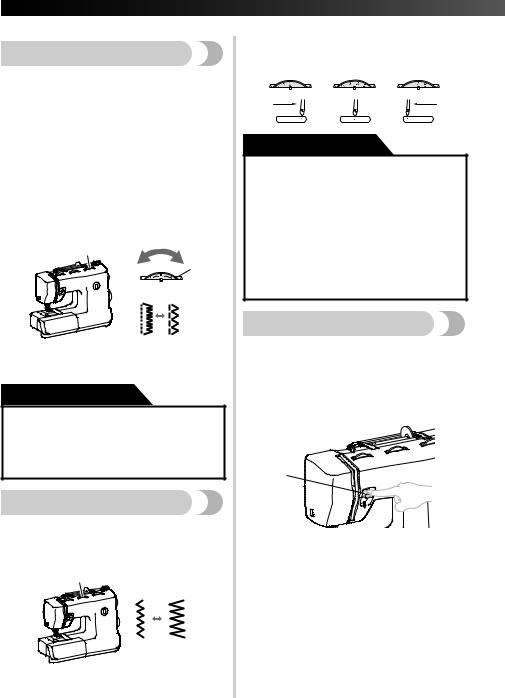
KNOWING YOUR SEWING MACHINE
Stitch length dial
Depending on the selected stitch, you may need to adjust the stitch length for best results.
The numbers marked on the stitch length dial represent the stitch length in millimeters (mm) (1/25 inch).
THE HIGHER THE NUMBER, THE LONGER THE STITCH. With the “0” setting, material is not fed. This is used when sewing a button.
The “F”-“1” range is for making a satin stitch (closed zigzag stitch), which is used for making buttonholes and decorative stitches. The position needed for making the satin stitch varies according to the material and thread being used. To determine the exact dial position, first test the stitch and length settings on a scrap piece of fabric to observe the feeding of the material.
1 |
2 |
3 |
|
|
1 |
1 Stitch length dial
2 Shorter
3 Longer
 CAUTION
CAUTION
●If the stitches are bunched together, lengthen the stitch length and continue sewing. Do not continue sewing without lengthening the stitch length, otherwise the needle may break and cause injury.
Stitch width dial
Raise the needle by turning the handwheel toward you (counterclockwise) so that the mark on the wheel points up. The numbers marked on the dial represent the stitch width.
1
1 Stitch width dial
—
When the Straight or Triple Stretch Stitch is selected, the needle position can be changed from left to right by adjusting the stitch width dial.
 CAUTION
CAUTION
●After adjusting the stitch width, slowly turn the handwheel toward you (counterclockwise) and check that the needle does not touch the presser foot. If the needle hits the presser foot, the needle may bend or break.
●If the stitches are bunched together, increase the stitch length. Continuing to sew with the stitches bunched together may result in the needle bending or breaking.
Reverse sewing lever
You can use reverse sewing for back tacking and reinforcing seams.
To sew in reverse, push the reverse sewing lever in as far as possible and hold it in that position while you lightly push the foot controller. To sew forward, release the reverse sewing lever. The machine will then sew forward.
1
1 Reverse sewing lever
13
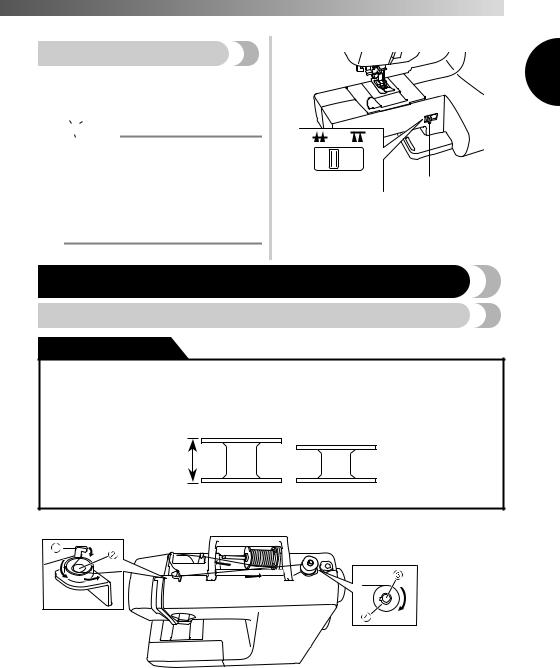
Feed dog position switch
Use the feed dog position switch to raise or lower the feed dogs according to the job that is being done. When darning or sewing on buttons, the feed dogs should be lowered. (The garment will not be fed.)


 Note
Note
●When raising or lowering the feed dogs, move the feed dog position switch as far as possible to the appropriate side. Since the feed dogs can not be lowered using the feed dog position switch immediately after they are raised, turn the handwheel toward you (counterclockwise) once and after the feed dogs are raised, lower them using the feed dog position switch.
1
3 2 1
2 1
1 Feed dog position switch
2 Down position
3 Up position
THREADING THE MACHINE
Winding the bobbin
 CAUTION
CAUTION
●We designed the bobbin that comes with this machine. If you use bobbins from other models, the machine will not work properly. Only use the bobbin that comes with this machine or bobbins of the same type (part code: SA156). Using other bobbins may cause damage to the machine.
Actual size
11.5 mm (7/16 inch)
This model |
|
Other models |
|
|
|
|
|
|
|
|
|
|
|
|
|
1 Hook of the bobbin-winding thread guide
2 Pre-tension disk
3 Bobbin winder shaft
4 Bobbin
14
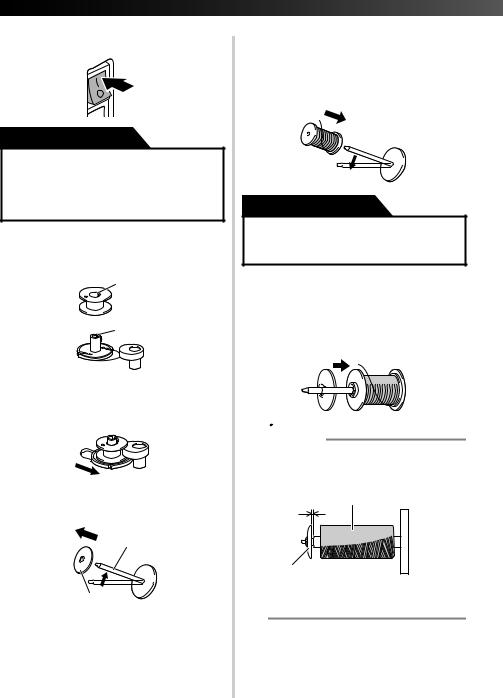
KNOWING YOUR SEWING MACHINE
1 Turn on the machine.
 CAUTION
CAUTION
●Do not turn on the machine while pressing down the foot controller. The machine may start unexpectedly and cause personal injury or damage to the machine.
2Place the bobbin on the bobbin winder shaft so that the spring on the shaft fits into the notch of the bobbin.
a
 b
b
1 Notch
2 Spring on the shaft
3Slide the bobbin winder shaft to the right until it snaps into place.
4Swing up the spool pin, and then remove the spool cap.
a
b
1 Spool pin
2 Spool cap
—
5Fully insert the spool of thread for the bobbin onto the spool pin.
Slide the spool onto the pin so that the spool is horizontal and the thread unwinds to the front at the bottom.
 CAUTION
CAUTION
●If the spool is not positioned so that the thread unwinds correctly, the thread may become tangled around the spool pin.
6Slide the spool cap onto the spool pin.
With the slightly rounded side of the spool cap positioned toward the left, slide the spool cap onto the spool pin as far as possible to the right so that the spool is moved to the right end of the spool pin.
 Memo
Memo
●When sewing with fine, cross-wound thread, use the small spool cap, and leave a small space between the cap and the spool.
c b
a 
1 Spool cap (small)
2 Spool (cross-wound thread)
3 Space
15
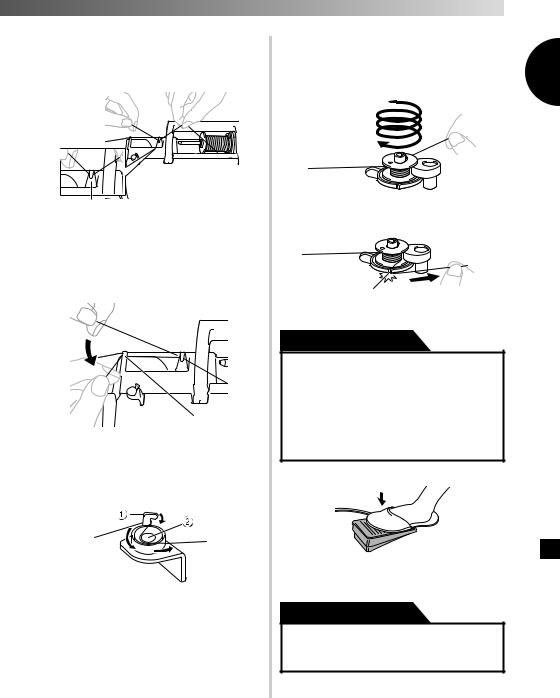
7While holding the spool with your right hand, pull the thread with your left hand, and then pass the thread under the thread guide A.
1
1 Thread guide A
8Pass the thread under the thread guide cover from the back to the front.
Hold the thread with your right hand so that there is no slack in the thread that is pulled out, and then pass the thread under the thread guide B with your left hand.
a
1 Thread guide B
9Pull the thread to the right, pass it under the hook of the bobbin-winding thread guide, and then wind the thread counterclockwise between the discs, pulling it in as far as possible.
1 Hook of the bobbin-winding thread guide
2 Pre-tension disk
0 While using your left hand to hold the |
|
thread that was passed through the bobbin- |
1 |
winding thread guide, use your right hand |
|
to wind the end of the thread clockwise |
around the bobbin five or six times.
aPass the end of the thread through the slit in the bobbin winder seat, and then pull the thread to the right to cut it.
a
1 Slit in bobbin winder seat (with built-in cutter)
X The thread is cut to a suitable length.
 CAUTION
CAUTION
●Be sure to cut the thread as described. If the bobbin is wound without cutting the thread using the cutter built into the slit in the bobbin winder seat, the bobbin may not be wound correctly. In addition, the thread may become tangled in the bobbin or the needle may bend or break when the bobbin thread starts to run out.
b Press the foot controller to start.
cWhen the bobbin seems full and begins spinning slowly, take your foot off the foot controller.
 CAUTION
CAUTION
●When the bobbin winding becomes slow, stop the machine, otherwise the sewing machine may be damaged.
16
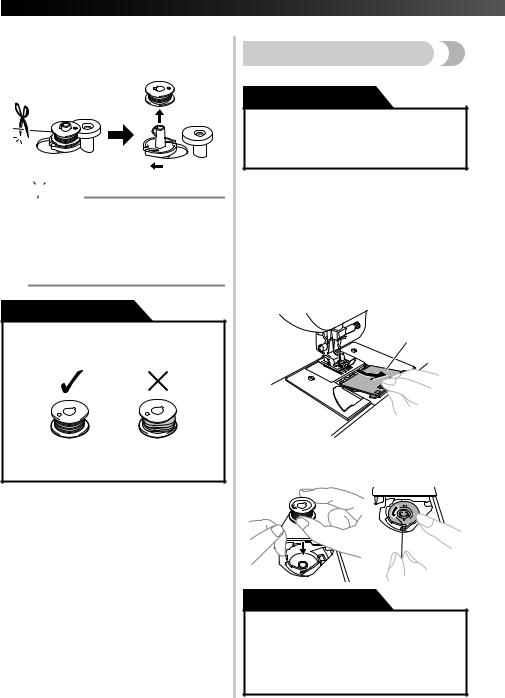
KNOWING YOUR SEWING MACHINE
dCut the thread, slide the bobbin winder shaft to the left, and then remove the bobbin from the shaft.


 Note
Note
●When the sewing machine is started or the handwheel is turned after winding the thread around the bobbin, the machine will make a clicking sound; this is not a malfunction.
●The needle bar does not move when you slide the bobbin winder shaft to the right.
 CAUTION
CAUTION
●Not winding the bobbin properly may cause the thread tension to loosen, and may break the needle.
12
1 Wound evenly
2 Wound poorly
—
Lower threading
Install the bobbin wound with thread.
 CAUTION
CAUTION
●Make sure you turn off the machine while threading. If you accidentally step on the foot controller and the machine starts to sew, you could be injured.
1Prepare the bobbin wound properly before threading the lower thread.
•See page 14 for the details about bobbin winding.
2Raise the needle by turning the handwheel toward you (counterclockwise) and raise the presser foot lever.
3Remove the bobbin cover by sliding it and lift toward you.
1
1 Bobbin cover
4Put the bobbin in so the thread comes out in the direction shown by the arrow.
 CAUTION
CAUTION
●Make sure you set the bobbin so the thread unrolls in the right direction. If the thread unrolls in the wrong direction, it may cause the thread tension to be incorrect or break the needle.
17
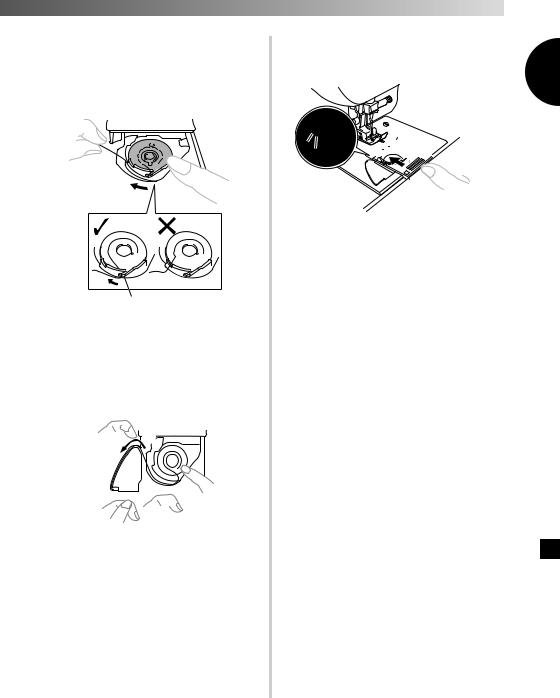
5Hold the end of the thread, push the bobbin down with your finger, and then pass the thread through the slit, as shown.
•If the thread is not correctly inserted through the tension-adjusting spring of the bobbin case, it may cause incorrect thread tension.
1
1 Tension-adjusting spring
6While lightly holding down the bobbin with your right hand as shown, guide the thread through the slit (1 and 2). Then, pull the thread toward you to cut it with the cutter (3).
•At this time, check that the bobbin easily rotates counterclockwise.
 2
2
1
2
 3
3  1
1
1 Slit
2 Cutter (Cut the thread with the cutter.)
7Replace the bobbin cover. Put the projection into the race retainer groove
and push closed. |
1 |
|
12









1 |
Groove |
2 |
Projection |
•Start sewing after threading the lower and upper thread. When sewing gathers or darts, you can draw up the lower thread by hand so that some thread will be left over. Refer to the steps in “Drawing up the lower thread” (page 23).
18
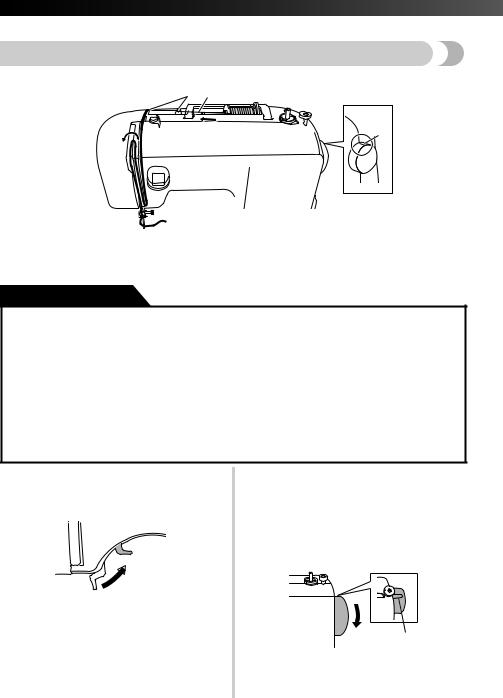
KNOWING YOUR SEWING MACHINE |
— |
Upper threading
2 1
 4
4
3
1 Spool pin
2 Thread guide
3 Thread take-up lever
4 Mark on the handwheel
 CAUTION
CAUTION
●When threading the upper thread, carefully follow the instructions. If the upper threading is not correct, the thread may become tangled or the needle may bend or break.
●Never use a thread weight of 20 or lower.
●Use the needle and the thread in the correct combination. For details on the correct combination of needles and threads, refer to “FABRIC, THREAD, AND NEEDLE COMBINATIONS” on page 24.
●The needle threader can be used with a 75/11 through 100/16 home sewing machine needle. However, the needle threader cannot be used with a 65/9 home sewing machine needle. When using special thread such as transparent nylon thread or metallic thread, the needle threader cannot be used.
●Thread with a thickness of 130/120 or thicker cannot be used with the needle threader.
●The needle threader cannot be used with the wing needle or the twin needle.
1Turn off the machine.
2Raise the presser foot lever.
 1
1
3Raise the needle by turning the handwheel toward you (counterclockwise) so that the mark on the wheel points up.
•If the needle is not correctly raised, the sewing machine can not be threaded.
1 Presser foot lever
1
1 Mark on the wheel
19
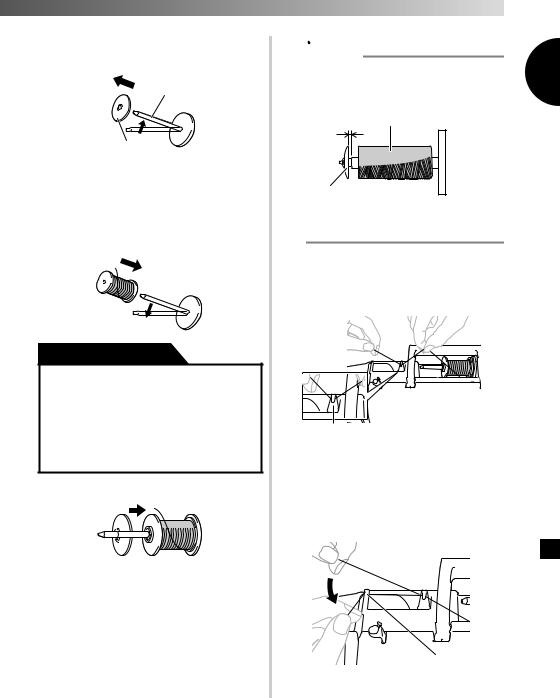
4Swing up the spool pin, and then remove the spool cap.
a
b
1 Spool pin
2 Spool cap
5Fully insert the spool for the upper thread onto the spool pin.
Slide the spool onto the pin so that the spool is horizontal and the thread unwinds to the front at the bottom.
 CAUTION
CAUTION
●If the spool is not positioned so that the thread unwinds correctly, the thread may become tangled around the spool pin and the thread or needle may break.
●If the spool cap that is used is smaller than the spool, the thread may catch, for example, on the notch in the spool, or the needle may break.
6 Slide the spool cap onto the spool pin.
 Memo
Memo
● When sewing with fine, cross-wound |
1 |
thread, use the small spool cap, and leave a |
small space between the cap and the spool.
c b
a 
1 Spool cap (small)
2 Spool (cross-wound thread)
3 Space
7While holding the spool with your right hand, pull the thread with your left hand, and then pass the thread under the thread guide A.
1
1 Thread guide A
8Pass the thread under the thread guide B from the back to the front.
Hold the thread with your right hand so that there is no slack in the thread that is pulled out, and then pass the thread under the thread guide B with your left hand.
a
1 Thread guide B
20
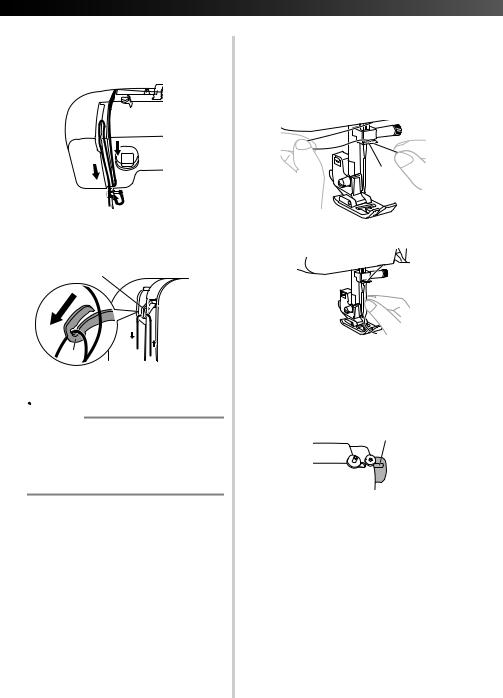
KNOWING YOUR SEWING MACHINE
9Thread the machine by guiding the thread along the path indicated by the number on the machine.
0Make sure you guide the thread through the thread take-up lever from right to left as shown in the following illustration.
1
1
1 Thread take-up lever
 Memo
Memo
●If the thread take-up lever is lowered, the upper thread can not be wrapped around the thread take-up lever. Make sure you raise the needle by turning the handwheel toward you (counterclockwise) so that the
mark on the wheel points up.
—
aPutneedle.the thread behind the guide above the
•The thread can easily be passed behind the needle bar thread guide by holding the thread in your left hand, then feeding the thread with your right hand.
1
1 Needle bar thread guide
bLower the presser foot lever.
cMake sure that the mark on the wheel points up as shown in the following illustration.
1
1 Mark on the wheel
21
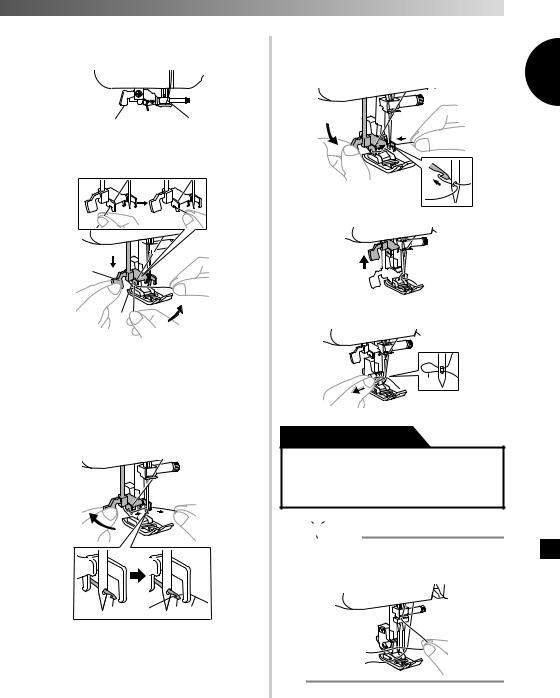
dWhile lowering the needle threader lever, hook the thread onto the guide.
2 1
1
1 Needle holder
2 Needle threader lever
1
2
1 Needle holder
2 Needle threader lever
3 Guide
ePull down the needle threader lever as much as possible, and then turn the lever toward the back of the machine (away from you). Make sure that the hook passes through the eye of the needle and grabs the thread.
11 2
1 Hook
2 Thread
•Hold the thread in front of the needle to make sure that the hook grabs it.
fWhile lightly holding the thread, turn the needle threader lever toward the front of
the machine (toward you). The hook will |
1 |
pull the thread through the needle. |
g Raise the needle threader lever.
hPull the loop of the thread passed through the eye of the needle toward the rear of the machine.
1
1 Loop of thread
 CAUTION
CAUTION
●Be careful not to pull on the thread with force or it may bend the needle.
●If the thread does not pass through the eye of the needle, start from step c again.


 Note
Note
●Needle threader cannot be used when using the twin needle. In this case, thread the needle as described below.
22
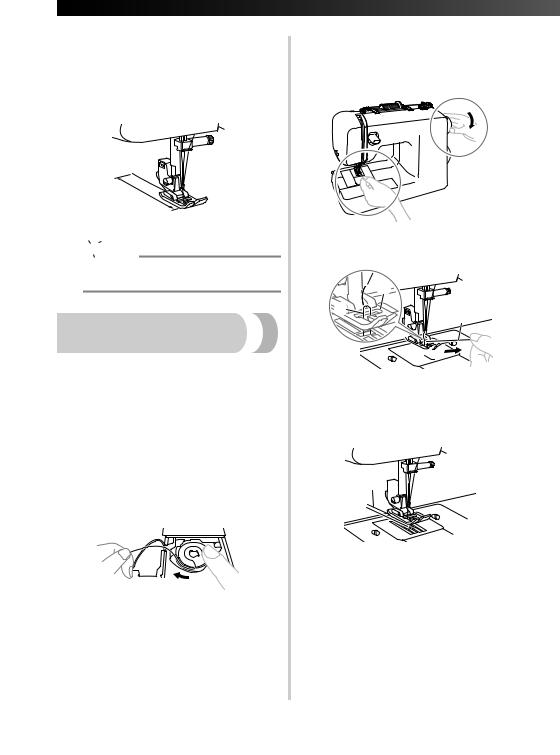
KNOWING YOUR SEWING MACHINE
iRaise the presser foot lever.
jPass the end of the thread through the presser foot, and then pull out about 5 cm (2 inches) of thread toward the rear of the machine.
1
1 5 cm (2 inches)


 Note
Note
●If you incorrectly feed the thread you may cause sewing problems.
Drawing up the lower thread
You can begin sewing immediately without drawing up the bobbin thread.
When sewing gathers or darts, you can draw up the lower thread by hand so that some thread will be left over. Before you draw up the lower thread, put the bobbin back in.
1Raise the presser foot lever.
2Remove the bobbin cover, and then reinstall the bobbin.
3Pass the thread along the slit in the direction of the arrow, and leave it there without cutting it.
• The bobbin cover should still be removed.
—
4While lightly holding the end of the upper thread, slowly turn the handwheel toward you (counterclockwise) by hand to lower and then raise the needle.
5Pull on the upper thread to draw up the lower thread.


 1
1
2


1
2



1 Upper thread
2 Lower thread
6Pull out about 10 cm (4 inches) of both threads and put them toward the back of the machine under the presser foot.
1 

2
1 Upper thread
2 Lower thread
7 Replace the bobbin cover.
23
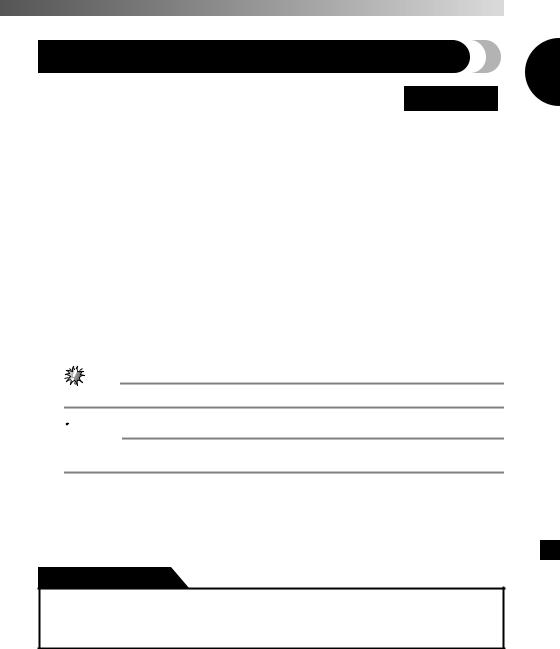
FABRIC, THREAD, AND NEEDLE COMBINATIONS
1
Fabric Type/Application |
|
Thread |
Size of Needle |
||
|
|
|
|||
Type |
|
Size |
|||
|
|
|
|
||
Medium weight |
Broadcloth |
Cotton thread |
|
60–90 |
|
Taffeta |
Synthetic thread |
|
75/11–90/14 |
||
fabrics |
|
|
|||
|
Flannel, Gabardine |
Silk thread |
|
50 |
|
|
Lawn |
Cotton thread |
|
60–90 |
|
Thin fabrics |
Georgette |
Synthetic thread |
|
65/9–75/11 |
|
|
|
||||
|
Challis, Satin |
Silk thread |
|
50 |
|
|
Denim |
Cotton thread |
|
30 |
100/16 |
Thick fabrics |
|
50 |
|
||
|
|
|
|
||
Corduroy |
Synthetic thread |
|
50–60 |
90/14–100/16 |
|
|
|
||||
|
Tweed |
Silk thread |
|
|
|
|
|
|
|
||
|
Jersey |
|
|
|
Ball point needle |
Stretch fabrics |
|
Thread for knits |
|
50–60 |
75/11–90/14 |
|
|
||||
|
Tricot |
|
|
|
(gold colored) |
|
|
|
|
|
|
|
|
Cotton thread |
|
50–90 |
|
|
|
|
|
|
|
Easily frayed fabrics |
Synthetic thread |
|
65/9–90/14 |
||
|
|
||||
|
|
|
|
|
|
|
|
Silk thread |
|
50 |
|
For top-stitching |
Synthetic thread |
|
30 |
100/16 |
|
|
|
|
|||
Silk thread |
|
50–60 |
75/11–90/14 |
||
|
|
|
|||
|
|
|
|
||
|
|
|
|
|
|
 Note
Note
● Never use a thread weighted #20 or lower. It may cause machine malfunction.
 Memo
Memo
●The lower the thread number, the thicker the thread; and the higher the needle number, the thicker the needle.
■Ball point needle
Use the ball point needle when sewing on stretch fabrics or fabrics where skipped stitches easily occur.
The factory recommended needle is “HG-4BR” (Organ). Schmetz needles “JERSEY BALL POINT” 130/705H SUK 90/14 may be used as a substitute.
■Transparent nylon thread
Use a 90/14 to 100/16 needle, regardless of the fabric or thread.
 CAUTION
CAUTION
●Make sure you follow the needle, thread, and fabric combinations listed in the table. Using the wrong combination, such as heavyweight fabric like denim with a small needle
(65/9-75/11), may bend or break the needle. The wrong combination may also cause the seam to be uneven, the fabric to pucker, or the machine to skip stitches.
24
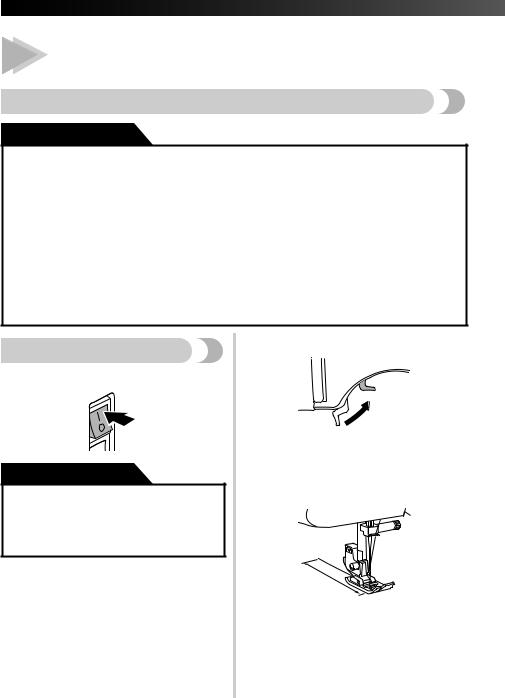
SEWING BASICS |
— |
2 SEWING BASICS
Please read before sewing
 CAUTION
CAUTION
●To avoid being injured, watch the needle carefully while you are using the machine. Keep your hands away from moving parts.
●Do not stretch or pull the fabric during sewing, otherwise the needle may be damaged and you may be injured.
●Do not use bent or broken needles, otherwise you may be injured.
●Take care that the needle does not hit basting pins or other objects during sewing. The needle may break and you may be injured.
●Always use the correct presser foot. If you use the wrong presser foot, the needle may hit the presser foot and bend or break and you may be injured.
●When you turn the handwheel by hand, always turn it toward you (counterclockwise). Turning it the other way may cause the thread to tangle and damage the needle or fabric, and you may be injured.
●Do not start sewing without placing the fabric under the presser foot, otherwise the presser foot may be damaged.
Starting sewing
1 Turn on the machine.
 CAUTION
CAUTION
●Do not turn on the machine while pressing down the foot controller. The machine may start unexpectedly and cause personal injury or damage to the machine.
2Raise the needle by turning the handwheel toward you (counterclockwise) so that the mark on the wheel points up.
3Turn the pattern selection dial to select a stitch (see page 9 - 12).
4Change the presser foot (see page 8).
5 Raise the presser foot lever.
 1
1
1 Presser foot lever
6Place the fabric under the presser foot, pass the thread under the presser foot, and then pull out about 5 cm (2 inches) of thread toward the rear of the machine.
1
1 5 cm (2 inches)
25
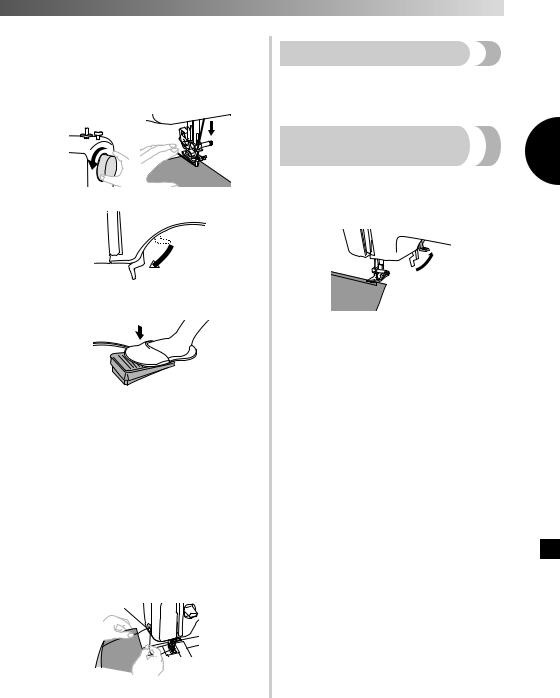
7While holding the end of the thread and the fabric with your left hand, turn the handwheel toward you (counterclockwise) with your right hand to lower the needle to the starting point of the stitching.
8Lower the presser foot lever.
 1
1
1 Presser foot lever
9 Slowly press down on the foot controller.
X The machine starts sewing.
0Take your foot off the foot controller.
X The machine stops sewing.
•You can use reverse sewing for back tacking and reinforcing seams by pressing the reverse sewing lever. Refer to “Reverse sewing lever” on page 13 for the details.
aRaise the needle by turning the handwheel toward you (counterclockwise).
bRaise the presser foot lever.
cPull the fabric to the left side of the machine, and then pass the threads
through the thread cutter to cut them.
.
1
1 Thread cutter
Trial sewing
A trial piece of fabric should be sewn. Use a piece of fabric and thread that are the same as those used for your project, and check the thread tension and stitch length and width.
Changing the sewing |
2 |
direction |
Stop the machine with the needle in the fabric at the point where you want to change the sewing direction, and then raise the presser foot lever. Using the needle as a pivot, turn the fabric, lower the presser foot lever, and then continue sewing.
1
 2
2
26
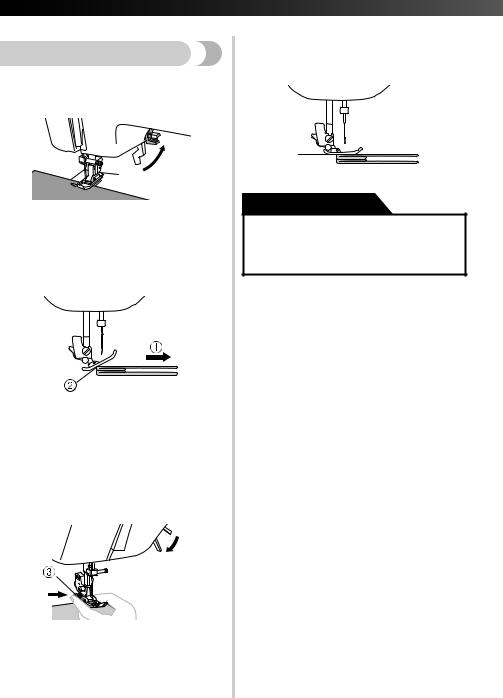
SEWING BASICS
Sewing thick fabrics
■If the fabric does not fit under the presser foot
If the fabric does not fit easily under the presser foot, raise the presser foot lever even higher to bring the presser foot to its highest position.
■If thick seams are being sewn and the fabric does not feed at the beginning of stitching
The fabric may not feed when thick seams are being sewn and the presser foot is not level.
In this case, use the presser foot locking pin (black button on the left side of zigzag foot “J”) so that the presser foot remains level while sewing, allowing the fabric to be fed smoothly.
1 Sewing direction
2 Misalignment
1Raise the presser foot lever.
2Align the beginning of stitching, and then position the fabric.
3While holding zigzag foot “J” level, hold the presser foot locking pin (black button on the left side) pressed in, and lower the presser foot lever.
3 Presser foot locking pin (black button)
—
4Releasebutton).the presser foot locking pin (black
X The presser foot remains level, allowing the fabric to be fed.
XAfter the seam is sewn, the presser foot will return to its original angle.
 CAUTION
CAUTION
●If fabric more than 6 mm (15/64 inch) thick is sewn or if the fabric is pushed with too much force, the needle may bend or break.
27
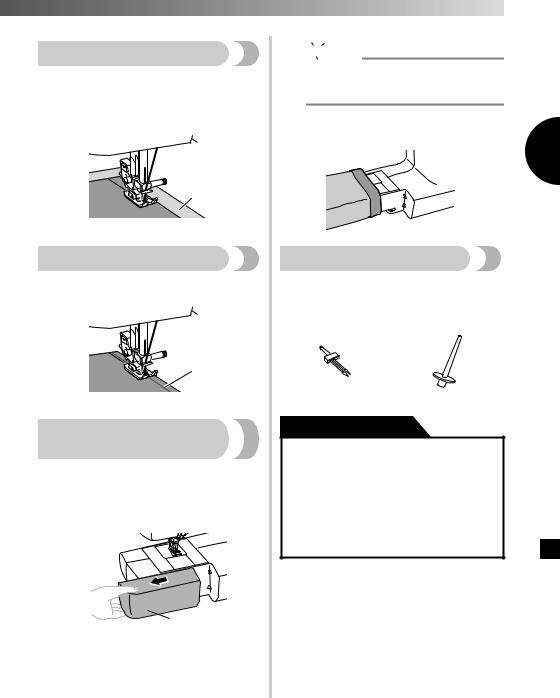
Sewing thin fabrics
When sewing thin fabrics, the stitching may become misaligned or the fabric may not feed correctly. If this occurs, place thin paper or stabilizer material under the fabric and sew it together with the fabric. When you have finished sewing, tear off any excess paper.
1
1 Stabilizer material or paper
Sewing stretch fabrics
First, baste the pieces of fabric together, and then sew without stretching the fabric.
1
1 Basting
Stitching cylindrical pieces
Removing the flat bed attachment makes it easier to sew cylindrical pieces such as cuffs and pant legs, or hard- to-reach areas.
1Slide the flat bed attachment to the left to release it.
1
1 Flat bed attachment
XWith the flat bed attachment removed, free-arm sewing is possible.


 Note
Note
●When you are finished with free-arm sewing, install the flat bed attachment back in its original position.
2Slide the part that you wish to sew onto the arm, and then sew from the top.
2
Sewing with a twin needle
We have designed your machine so you can sew with this needle and two top threads. You can use the same color or two different colors of thread for making decorative stitches.
1 Twin needle |
2 Extra spool pin |
 CAUTION
CAUTION
●Use only twin needles that have been made for this machine (part code: X57521-021:2.0/75 with a 2 mm width). Other needles could break and damage the machine.
●Make sure that the needle does not strike the presser foot.
●Do not sew with bent needles. The
needle could break and injure you.
■Attaching the twin needle
Attach the twin needle in the same way as a single needle (see page 7–8). The flat side of the needle should face toward the back and the rounded side should face toward you.
28
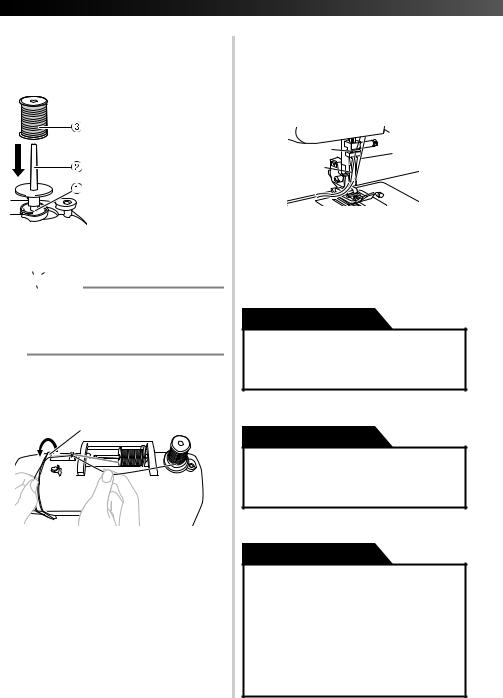
SEWING BASICS
■Attaching the extra spool pin
Insert the extra spool pin onto the end of the bobbin winder shaft. Install the second thread spool onto the extra spool pin.
1 Bobbin winder shaft
2 Extra spool pin
3 Thread spool
■Twin needle threading
You should thread each needle separately.


 Note
Note
●You cannot use the needle threader to thread the twin needle. Instead, thread the twin needle by hand, from front to back. Using the needle threader may damage the machine (see page 23).
1Thread the upper thread for the right side in the same way that the upper thread for the left side was threaded.
1
1 Thread guide
•For details, refer to step 1 through 0 of “Upper threading” (page 19).
2 Thread the left needle.
—
3 Thread the right needle.
Thread the right needle in the same way that you threaded the left needle using the thread from the spool on the extra spool pin, but do not pass the thread through the guide above the needle before you pass it through the eye of the right needle.
3 |
2 |
|
|
1 |
|
1 Left needle thread passes through the needle bar thread guide
2 Right needle thread passes in front of the needle bar thread guide
3 Needle bar thread guide
4Attach zigzag foot “J”.
For details on changing the presser foot, refer to “Changing the presser foot” on page 8.
 CAUTION
CAUTION
●When using the twin needle, be sure to attach zigzag foot “J”, otherwise the needle may break or the machine may be damaged.
5 Turn on the machine.
 CAUTION
CAUTION
●Do not turn on the machine while pressing down the foot controller. The machine may start unexpectedly and cause personal injury or damage to the machine.
6 Select a stitch.
 CAUTION
CAUTION
●After adjusting the stitch width, slowly turn the handwheel toward you (counterclockwise) and check that the needle does not touch the presser foot. If the needle hits the presser foot, the needle may bend or break.
●When using the twin needle, make sure the stitch width is not set above “2.5” since this may cause the needle to hit the needle plate and break.
29
